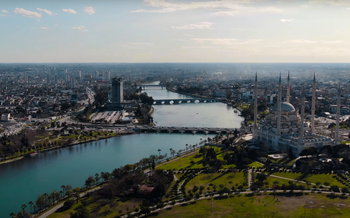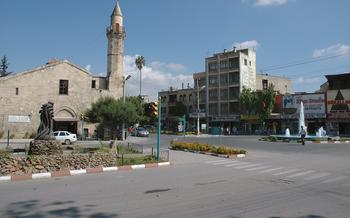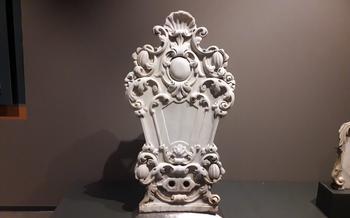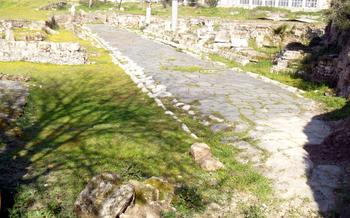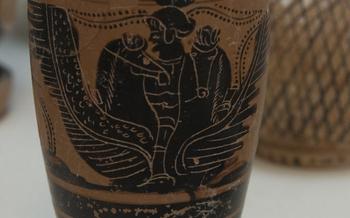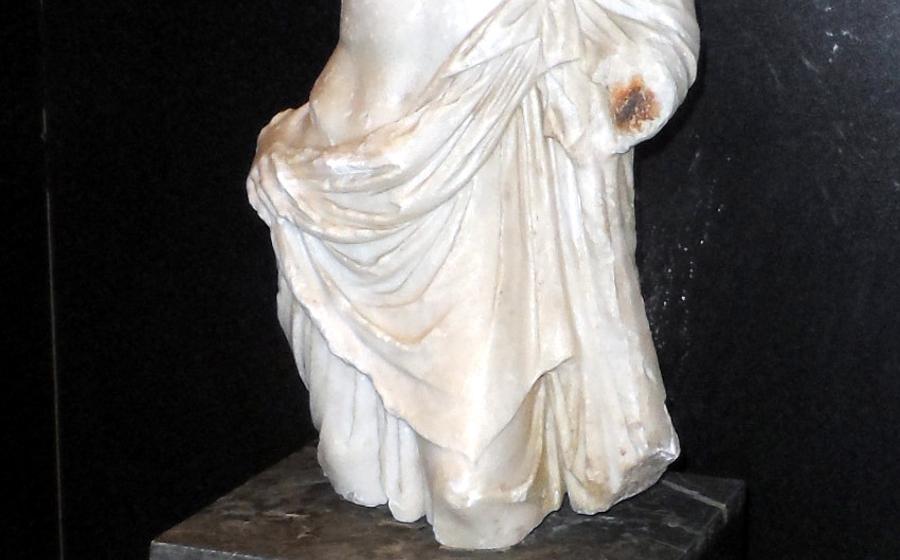
Tarsus Museum
- Unveiling the City's Ancient Heritage
- Mosaics: Masterpieces of Art and Craftsmanship
- Sculptures: Glimpses into the Past
- Ceramics: Everyday Objects with Artistic Flair
- Coins: A Window into Economic and Political History
- Jewelry: Adornments of Beauty and Prestige
- Glassware: Fragile Treasures of Ancient Craftsmanship
- Textiles: Woven Stories of History
- Interactive Exhibits: Engaging with the Past
- Guided Tours: Unveiling Hidden Stories
- Educational Programs: Learning Through History
- Museum Shop: Unique Souvenirs and Gifts
- Accessibility: Making History Inclusive
- Insider Tip: Unveiling Hidden Gems
Unveiling the City's Ancient Heritage
Tarsus, an ancient city steeped in history, played a significant role in the development of civilizations. The Tarsus Museum houses a remarkable collection of artifacts that tell the story of the city's rich past from various periods, including the Roman, Byzantine, and Ottoman eras. One of the highlights of the museum is the collection of exhibits showcasing Tarsus's connection to famous figures, such as the Apostle Paul, who spent a considerable amount of time in the city during his missionary journeys. Through interactive displays and multimedia presentations, visitors can delve deeper into the lives and contributions of these influential individuals, gaining a deeper understanding of Tarsus's role in shaping history.
Mosaics: Masterpieces of Art and Craftsmanship
Among the museum's most prized possessions is its collection of ancient mosaics, renowned for their intricate designs, vibrant colors, and exceptional craftsmanship. Step into a world where mythology, history, and everyday life come together in these exquisite works of art.
Skilled artisans used a variety of techniques to create these mosaics, including the opus tessellatum, where small, square tiles called tesserae are arranged to form intricate patterns and figures. In the opus vermiculatum technique, smaller, irregular pieces are used to create more detailed and delicate designs.
The themes depicted in the mosaics are as diverse as the city's history itself. Mythological scenes from Greek and Roman legends come to life, with gods, goddesses, and heroes depicted in vivid detail. Everyday activities, such as hunting, fishing, and farming, are also captured in these intricate artworks.
One of the most famous mosaics is the "Medea Mosaic", which portrays the tragic Greek heroine as she prepares to kill her children. The mosaic's expressive figures and rich colors captivate visitors, offering a glimpse into the storytelling prowess of ancient artists.
Another highlight is the "Alexander Mosaic", which depicts the legendary battle between Alexander the Great and King Darius III of Persia. The mosaic's intricate details and sense of movement bring the epic battle to life, showcasing the skill and artistry of the mosaicists.
As you wander through the museum's mosaic collection, you'll discover a treasure trove of stories, myths, and historical events, all immortalized in these exquisite works of art. Each mosaic tells a unique tale, inviting visitors to delve deeper into the rich cultural heritage of Tarsus.
Sculptures: Glimpses into the Past
The Tarsus Museum boasts an impressive collection of sculptures that offers a glimpse into the artistic prowess and cultural heritage of the region. These sculptures, crafted from various materials such as marble, limestone, and bronze, depict a diverse range of subjects, including gods, goddesses, heroes, and historical figures.
One of the most notable sculptures in the collection is a larger-than-life-size marble statue of the Roman emperor Hadrian. This majestic sculpture showcases the emperor's power and authority, with intricate details capturing his facial features, clothing, and posture.
Another highlight is a bronze statue of the Greek god Hermes, the messenger of the gods. This elegant and dynamic sculpture portrays Hermes in motion, with his winged sandals and flowing cloak adding a sense of movement and energy to the piece.
Visitors can also admire a collection of funerary sculptures, including stelae and sarcophagi, which provide insights into the beliefs and practices of the ancient people of Tarsus. These sculptures often feature intricate carvings depicting scenes from mythology, everyday life, or the afterlife.
The Tarsus Museum's sculpture collection is a testament to the skill and artistry of ancient craftsmen and offers a fascinating glimpse into the cultural and historical heritage of the region.
Ceramics: Everyday Objects with Artistic Flair
The Tarsus Museum houses a remarkable collection of ancient ceramics that offers a glimpse into the daily lives and artistic traditions of the region's inhabitants. These ceramic pieces, ranging from utilitarian pottery to decorative vessels, showcase the skill and artistry of ancient craftsmen.
The collection includes a variety of ceramic types, each serving a specific purpose. From humble cooking pots and storage jars to elegant tableware and decorative vases, these objects provide a tangible connection to the domestic and ritual practices of ancient Tarsus.
The techniques used in creating these ceramics are as diverse as the forms themselves. Hand-built and wheel-thrown pottery, with intricate patterns and glazes, demonstrate the technical prowess of the ancient potters. The use of local clays and natural pigments adds to the uniqueness of each piece.
Beyond their practical functionality, these ceramics often bear artistic motifs and iconography that reflect the cultural and religious beliefs of the time. Depictions of deities, mythical creatures, and scenes from everyday life adorn these vessels, offering valuable insights into the visual language and storytelling traditions of ancient Tarsus.
The museum's collection of ceramics is not merely a display of beautiful objects but a testament to the creativity and ingenuity of the ancient artisans who crafted them. These everyday objects, once used for cooking, storage, and decoration, now stand as enduring works of art, preserving the rich cultural heritage of Tarsus.
Coins: A Window into Economic and Political History
The Tarsus Museum boasts an impressive collection of ancient coins, offering a glimpse into the economic and political history of the region. These coins, minted during various periods and by different rulers, provide valuable insights into the monetary systems, trade networks, and political power structures of ancient times.
Visitors can admire a diverse array of coins, from small bronze pieces to larger silver and gold coins. Each coin bears unique designs and inscriptions, reflecting the artistic styles and symbols of its time. Some coins feature portraits of rulers or deities, while others depict mythological scenes or symbols of power.
By studying these ancient coins, historians and numismatists can gain insights into the economic and political dynamics of the ancient world. The coins reveal information about the value of different metals, the exchange rates between currencies, and the minting practices of various rulers. They also shed light on trade routes, taxation systems, and the economic relationships between different cities and empires.
For those interested in ancient history and economics, the coin collection at the Tarsus Museum is a treasure trove of information. These small, metallic objects offer a tangible connection to the past, providing valuable insights into the economic and political forces that shaped the ancient world.
Jewelry: Adornments of Beauty and Prestige
The Tarsus Museum boasts an exquisite collection of ancient jewelry, showcasing the artistry and craftsmanship of past civilizations. From delicate necklaces and earrings to intricately designed bracelets and rings, these adornments offer a glimpse into the fashion, status, and cultural practices of ancient times.
Crafted from precious metals such as gold and silver, as well as semi-precious stones, these pieces were not merely decorative but held significant social and cultural meanings. They symbolized wealth, power, and prestige, and were often worn to mark special occasions, religious ceremonies, and important milestones in life.
The museum's jewelry collection includes a variety of styles and designs, reflecting the diverse influences that shaped the region. From the elegant simplicity of geometric patterns to the intricate details of floral motifs, each piece tells a story of the craftsmanship and artistry of its time.
One of the highlights of the collection is a beautifully preserved gold necklace adorned with precious gems. Its intricate design features a central pendant in the shape of a crescent moon, symbolizing fertility and protection. The necklace's delicate chain and intricate filigree work showcase the skill and precision of the ancient goldsmiths.
Another notable piece is a silver bracelet adorned with colorful gemstones. The bracelet's design incorporates symbolic motifs such as the evil eye, believed to ward off negative energy and bring good luck. The combination of vibrant colors and intricate craftsmanship makes this bracelet a true masterpiece.
These are just a few examples of the stunning jewelry collection at the Tarsus Museum. Each piece offers a unique glimpse into the lives and cultures of the people who wore them, providing a tangible connection to the past and the enduring allure of ancient craftsmanship.
Glassware: Fragile Treasures of Ancient Craftsmanship
The Tarsus Museum houses a remarkable collection of ancient glassware, offering visitors a glimpse into the artistry and craftsmanship of past civilizations. These delicate treasures, meticulously crafted by skilled artisans, showcase the diverse forms and functions of glassware in ancient times. From elegant drinking vessels to decorative items, each piece tells a story of everyday life and cultural customs.
The museum's glassware collection encompasses a wide range of objects, including cups, bowls, plates, jugs, and vases. Visitors can admire the intricate designs and patterns adorning these vessels, which were often used for special occasions and religious ceremonies. The vibrant colors and clarity of the glass reflect the advanced techniques employed by ancient glassmakers, who mastered the art of manipulating molten glass to create beautiful and functional objects.
One of the highlights of the collection is a stunning glass bottle with a long, slender neck and a flared rim. Its surface is adorned with intricate engravings depicting scenes from mythology, showcasing the skill and artistry of the craftsman who created it. Another notable piece is a delicate glass lamp, its intricate shape and intricate patterns reflecting the importance of light and illumination in ancient cultures.
The Tarsus Museum's glassware collection offers a fascinating glimpse into the lives and traditions of ancient civilizations. These fragile treasures, preserved with care, invite visitors to appreciate the beauty and craftsmanship of a bygone era.
Textiles: Woven Stories of History
The Tarsus Museum boasts an impressive collection of ancient textiles that provide a glimpse into the rich cultural heritage of the region. From intricately woven clothing to decorative tapestries and carpets, these textiles showcase the skill and artistry of ancient craftsmen.
Visitors can admire a wide variety of textiles, each with its unique story to tell. Some of the most notable pieces include finely embroidered garments, colorful tapestries depicting mythological scenes, and beautifully patterned carpets that adorned the floors of wealthy homes.
The techniques and materials used in creating these textiles are fascinating in their own right. Visitors can learn about the different types of fibers employed, such as wool, linen, and silk, and the intricate weaving and dyeing processes that transformed them into stunning works of art.
Beyond their aesthetic appeal, these textiles offer valuable insights into the daily lives and customs of ancient people. They reveal information about fashion trends, social status, religious beliefs, and economic activities. For example, elaborate garments with intricate embroidery were often worn by wealthy individuals to display their opulence, while simpler textiles were used for everyday wear.
Exploring the museum's textile collection is a journey through time, allowing visitors to connect with the past and appreciate the artistry and craftsmanship of ancient civilizations.
Interactive Exhibits: Engaging with the Past
The Tarsus Museum brings history to life through interactive exhibits and multimedia presentations, making it an engaging and immersive experience for visitors of all ages. Virtual reality experiences transport you back in time, allowing you to explore ancient Tarsus and witness historical events as if you were there. Touchscreens offer in-depth information on artifacts and historical figures, while hands-on activities let you experience the past in a tangible way. These interactive elements not only enhance the visitor experience but also make learning about history fun and interactive.
One of the most popular interactive exhibits is the "Virtual Reality Time Machine," which takes you on a journey through Tarsus's rich history. You can explore the ancient city, visit important landmarks, and interact with historical figures. Another popular exhibit is the "Touchscreen Timeline," which allows you to browse through Tarsus's history by swiping through interactive panels. You can learn about key events, view historical maps, and zoom in on significant artifacts.
The museum also offers educational games and quizzes that make learning about history fun and engaging. These interactive activities are perfect for families with children, as they provide a hands-on way to explore the past. The Tarsus Museum's interactive exhibits and multimedia presentations are a testament to its commitment to providing visitors with a dynamic and memorable experience.
Guided Tours: Unveiling Hidden Stories
For a more immersive and in-depth exploration of the Tarsus Museum, guided tours are available in multiple languages. Led by knowledgeable and passionate guides, these tours offer visitors the opportunity to delve deeper into the stories behind the artifacts and exhibits. The guides provide expert insights and explanations, bringing the museum's collection to life.
Guided tours typically cover the main highlights of the museum, including the ancient mosaics, sculptures, ceramics, and coins. However, they also delve into lesser-known exhibits and hidden gems that visitors might miss on their own. For example, the guides might point out subtle details in the mosaics or share fascinating anecdotes about the people and events depicted in the sculptures.
To book a guided tour, visitors can either contact the museum in advance or inquire at the information desk upon arrival. It is advisable to book a tour in advance, especially for larger groups or during peak tourist season. The cost of a guided tour is usually included in the museum's admission fee.
Taking a guided tour at the Tarsus Museum is an excellent way to maximize the visitor experience. With the help of knowledgeable guides, visitors can gain a deeper understanding of the museum's collection and the rich history and culture of Tarsus.
Educational Programs: Learning Through History
The Tarsus Museum offers a range of educational programs designed to engage and inspire students of all ages. These programs aim to bring history to life and foster a deeper understanding of the region's rich cultural heritage.
Schools and groups can book educational programs that align with their curriculum and interests. Workshops, lectures, and hands-on activities are tailored to different age groups and learning styles. Through these programs, students can explore the museum's artifacts, uncover hidden stories, and gain insights into the past.
The museum's knowledgeable educators lead these programs, providing expert guidance and facilitating interactive discussions. Students have the opportunity to ask questions, engage in debates, and collaborate with their peers. By actively participating in these programs, students develop critical thinking skills, enhance their problem-solving abilities, and foster a lifelong love of learning.
To book an educational program, schools and groups can contact the museum's education department. The museum staff will assist with scheduling and provide additional information. Incorporating the museum's educational programs into school curricula offers a unique and enriching learning experience that complements classroom lessons and textbooks. These programs not only educate students about history but also cultivate their curiosity, creativity, and passion for exploring the world around them.
Museum Shop: Unique Souvenirs and Gifts
The Tarsus Museum gift shop is a treasure trove of unique souvenirs and gifts that will delight history buffs and art enthusiasts alike. From replicas of ancient artifacts to books and educational materials, the gift shop offers a wide range of items to commemorate your visit to the museum.
One of the highlights of the gift shop is the collection of replica artifacts. These replicas are meticulously crafted to resemble the originals, allowing visitors to take home a piece of history. From miniature sculptures to fragments of mosaics, these replicas make for meaningful souvenirs that will remind you of your time at the Tarsus Museum.
The gift shop also offers a variety of books and educational materials related to the history and culture of Tarsus. These books provide in-depth information on the city's ancient heritage, its famous figures, and the artifacts housed in the museum. Whether you're a history buff looking to learn more about Tarsus or simply want to find a unique gift for a friend or family member, the museum gift shop has something for everyone.
By purchasing items from the museum gift shop, you not only take home a piece of history but also support the museum and its mission. The revenue generated from the gift shop helps fund the museum's educational programs, conservation efforts, and ongoing research. So, when you visit the Tarsus Museum, be sure to stop by the gift shop and find a special souvenir or gift that will remind you of your journey through history.
Accessibility: Making History Inclusive
The Tarsus Museum is committed to making history accessible and inclusive for all visitors, regardless of their abilities or disabilities. The museum features wheelchair ramps and elevators to ensure that all visitors can easily navigate the galleries. Audio guides are available for visitors with hearing impairments, providing detailed descriptions of the exhibits in multiple languages. The museum also offers programs and resources for visitors with special needs, such as guided tours with sign language interpreters or tactile exhibits for visitors with visual impairments. The staff at the Tarsus Museum is dedicated to creating a welcoming and accessible environment for all visitors, ensuring that everyone has the opportunity to explore and learn from the museum's rich collection.
Insider Tip: Unveiling Hidden Gems
Amidst the wealth of artifacts and exhibits at the Tarsus Museum, there lies a hidden gem that often goes unnoticed by visitors. Tucked away in a corner of the sculpture gallery, you'll find a small, unassuming statue of a young boy. While it may not be the most elaborate or grand piece in the museum, this statue holds a special charm and significance.
Crafted from white marble, the statue depicts a boy with a mischievous smile and a playful glint in his eyes. His hair is tousled, as if he has just been running through the fields. The statue's creator has captured a moment of pure joy and innocence, making it a true masterpiece.
What makes this statue so special is its connection to a famous historical figure. According to local legend, this statue is believed to be a depiction of a young St. Paul, who spent his early years in Tarsus. While there is no concrete evidence to support this claim, the statue's striking resemblance to early depictions of St. Paul has led many to believe that it is indeed a representation of the apostle.
Whether or not the statue truly depicts a young St. Paul, it is a beautiful and captivating work of art that deserves to be discovered and appreciated. So, as you wander through the halls of the Tarsus Museum, be sure to keep an eye out for this hidden gem. It may just be the most memorable part of your visit.

